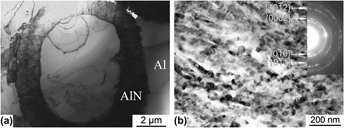Crossref Citations
This article has been cited by the following publications. This list is generated based on data provided by
Crossref.
Balog, M.
Yu, P.
Qian, M.
Behulova, M.
Svec, P.
and
Cicka, R.
2013.
Nanoscaled Al–AlN composites consolidated by equal channel angular pressing (ECAP) of partially in situ nitrided Al powder.
Materials Science and Engineering: A,
Vol. 562,
Issue. ,
p.
190.
Balog, M.
Krizik, P.
Yan, M.
Simancik, F.
Schaffer, G.B.
and
Qian, M.
2013.
SAP-like ultrafine-grained Al composites dispersion strengthened with nanometric AlN.
Materials Science and Engineering: A,
Vol. 588,
Issue. ,
p.
181.
Zhou, Yang
Zhao, Naiqin
Shi, Chunsheng
Liu, Enzuo
Du, Xiwen
and
He, Chunnian
2014.
In-situ processing and aging behaviors of MgAl2O4 spinel whisker reinforced 6061Al composite.
Materials Science and Engineering: A,
Vol. 598,
Issue. ,
p.
114.
Fale, Sandeep
Likhite, Ajay
and
Bhatt, Jatin
2014.
The Wear Behavior of In-Situ Al–AlN Metal Matrix Composites.
Transactions of the Indian Institute of Metals,
Vol. 67,
Issue. 6,
p.
841.
Balog, M.
Simancik, F.
Krizik, P.
Nosko, M.
Rajner, W.
Walcher, M.
and
Qian, M.
2014.
Light Metals 2014.
p.
1425.
Yang, Wei-wei
Guo, Zhi-meng
Guo, Lei-chen
Cao, Hui-qin
Luo, Ji
and
Ye, An-ping
2014.
In situ fabrication and properties of AlN dispersion strengthened 2024 aluminum alloy.
International Journal of Minerals, Metallurgy, and Materials,
Vol. 21,
Issue. 12,
p.
1228.
Sun, Yufu
Lyu, Yezhe
Jiang, Airong
and
Zhao, Jingyu
2014.
Fabrication and characterization of aluminum matrix fly ash cenosphere composites using different stir casting routes.
Journal of Materials Research,
Vol. 29,
Issue. 2,
p.
260.
Balog, M.
Simancik, F.
Krizik, P.
Nosko, M.
Rajner, W.
Walcher, M.
and
Qian, M.
2014.
Light Metals 2014.
p.
1423.
Jia, Lei
Kondoh, Katsuyoshi
Imai, Hisashi
Onishi, Motohiro
Chen, Biao
and
Li, Shu-feng
2015.
Nano-scale AlN powders and AlN/Al composites by full and partial direct nitridation of aluminum in solid-state.
Journal of Alloys and Compounds,
Vol. 629,
Issue. ,
p.
184.
Lee, Kon-Bae
Kim, Yong Hwan
Choi, Hyun Joo
and
Ahn, Jae-Pyoung
2016.
Effect of carbon on the nitridation behavior of aluminum powder.
Journal of Alloys and Compounds,
Vol. 689,
Issue. ,
p.
218.
Lee, Kon-Bae
Yoo, Seong-Hyeon
Kim, Yong-Hwan
Han, Chul-Woong
Won, Sung-Ok
Ahn, Jae-Pyung
and
Choi, Hyun-Joo
2017.
A cost-effective route to produce Al/AlN composites with low coefficient of thermal expansion.
Journal of Composite Materials,
Vol. 51,
Issue. 20,
p.
2845.
Chen, Cunguang
Wang, Wenwen
Guo, Zhimeng
Sun, Chunbao
Volinsky, Alex A.
and
Paley, Vladislav
2018.
Annealing Effects on Microstructure and Mechanical Properties of Ultrafine-Grained Al Composites Reinforced with Nano-Al2O3 by Rotary Swaging.
Journal of Materials Engineering and Performance,
Vol. 27,
Issue. 4,
p.
1738.
Chernousov, Andrey A.
and
Chan, Ben Y.B.
2019.
Oxynitride dendritic strengthening in pre-melted aluminium flakes through controlled in situ nitridation.
Journal of Alloys and Compounds,
Vol. 806,
Issue. ,
p.
841.
Mohanavel, Vinayagam
and
Ravichandran, Manickam
2019.
Experimental investigation on mechanical properties of AA7075-AlN composites.
Materials Testing,
Vol. 61,
Issue. 6,
p.
554.
Mahamani, Arumugam
2019.
Influence of Particle Size on Machinability Behavior in Turning of AA6061-AlN Composites.
International Journal of Materials Forming and Machining Processes,
Vol. 6,
Issue. 1,
p.
53.
Amirkhanlou, Sajjad
and
Ji, Shouxun
2020.
A review on high stiffness aluminum-based composites and bimetallics.
Critical Reviews in Solid State and Materials Sciences,
Vol. 45,
Issue. 1,
p.
1.
Bombač, David
Cvahte, Peter
Balog, Martin
Kugler, Goran
and
Terčelj, Milan
2020.
In-Depth Comparison of an Industrially Extruded Powder and Ingot Al Alloys.
Metals,
Vol. 10,
Issue. 11,
p.
1483.
Chen, B.
Kondoh, K.
Li, J.S.
and
Qian, M.
2020.
Extraordinary reinforcing effect of carbon nanotubes in aluminium matrix composites assisted by in-situ alumina nanoparticles.
Composites Part B: Engineering,
Vol. 183,
Issue. ,
p.
107691.
Balog, Martin
Krizik, Peter
Svec, Peter
and
Orovcik, Lubomir
2021.
Industrially fabricated in-situ Al-AlN metal matrix composites (part A): Processing, thermal stability, and microstructure.
Journal of Alloys and Compounds,
Vol. 883,
Issue. ,
p.
160858.
Schramm Deschamps, Isadora
dos Santos Avila, Daniel
Vanzuita Piazera, Enzo
Dudley Cruz, Robinson Carlos
Aguilar, Claudio
and
Klein, Aloisio Nelmo
2022.
Design of In Situ Metal Matrix Composites Produced by Powder Metallurgy—A Critical Review.
Metals,
Vol. 12,
Issue. 12,
p.
2073.





